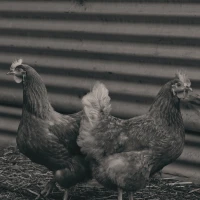The world of poultry is as diverse as it is fascinating, with an array of chicken breeds that capture the imagination and delight the senses. Among them, black and white chicken breeds stand out for their striking contrast and arresting patterns. Not only are these breeds a feast for the eyes, blending into the bucolic countryside and exquisitely patterned to perfection, but they also contribute significantly to our culinary repertoire, gracing our tables with their flavorful and nutritious offerings.
If you’re a culinary adventurist or a poultry enthusiast, you’re in for a treat. This in-depth exploration of the most captivating black and white chicken breeds will unveil a world where elegance meets utility. From the backyard coop to the gourmet kitchen, get ready to discover breeds that hold a special place in the food world.
An Overture to Ornamental Elegance
Before we delve into the specific breeds, let’s establish a foundation of understanding. Black and white chicken breeds are often prized for their contrasting plumage, which makes them visually stunning and highly sought after for ornamental purposes. However, beyond their beauty, many of these breeds are also cherished for their culinary attributes, offering tender meats and rich eggs that are beloved by chefs and home cooks alike.
The Dominique: America’s Pioneering Breed
One of the oldest recognized chicken breeds in the United States, the Dominique is a dual-purpose fowl known for its distinctive “cuckoo” or barred plumage. These hardy birds are not only aesthetically pleasing but also practical for small farms and homesteads.
- Appearance: The Dominique sports a bold pattern of alternating black and white bars that provide a rustic elegance to any farmstead.
- Culinary Fame: Known for its succulent meat and reliable egg production, the Dominique chicken serves as both a table bird and a layer of medium-sized brown eggs.
The Plymouth Rock: The Quintessential Dual-Purpose Bird
Another iconic black and white chicken breed is the Plymouth Rock. It has cemented its place in both the history and the future of poultry, celebrated for its balanced attributes.
- Appearance: The Plymouth Rock’s barred feathers carry the same black and white pattern but with a more pronounced heft, befitting its robust frame.
- Culinary Accolades: Whether for hearty stews or farm-fresh eggs, this breed’s culinary versatility is unparalleled, producing meat with deep flavor and large, nutritious eggs.
The Aristocrats of the Aviary
The Silkie: A Unique Delight
Venturing into the realm of the rare and exotic, one cannot overlook the Silkie, a breed that turns heads and captivates the senses. While not barred like the others, the Silkie deserves a mention for its stark black and white variation and its culinary reputation in specific cultural contexts.
- Exquisite Form: The Silkie enchants with its fluffy plumage, often in one solid color – either deep black or snowy white, and its distinctive blue skin.
- Culinary Reverence: A staple in traditional Chinese medicine for its purported health benefits, Silkie meat is a gourmet ingredient in many Asian cuisines.
The Lakenvelder: Graceful and Alert
Now, onto the Lakenvelder, a breed that encapsulates the essence of pastoral beauty with its Dutch heritage. The Lakenvelder, marked by a characteristic white “bib” on a primarily black body, is a vision of poise and grace in the field.
- Striking Contrast: Its sharp delineation between black and white feathers doesn’t go unnoticed in any flock.
- Culinary Standpoint: When it comes to the table, the Lakenvelder may be less common, but its lean and flavorful meat is a hidden gem for poultry connoisseurs.
The Appenzeller Spitzhauben: The Swiss Sentinel
Few chickens can claim a more dramatic flair than the Appenzeller Spitzhauben. With a name as unique as its appearance, this breed boasts both a stunning plumage pattern and a distinctive crest.
- Dramatic Attire: The Spitzhauben, with its ‘V’-shaped comb and stark feather patterns, is unmistakably noble.
- Culinary Contribution: While not a heavy meat producer, its eggs are a valuable culinary addition, lending variety to the palette of flavors and textures that chickens provide.
A Tapestry of Utility
The Ancona: The Mediterranean Marvel
Our journey through black and white chicken breeds takes us to the picturesque landscapes of Italy, where the Ancona originates. Sporting a mottled plumage of black flecked with white, this breed is a testament to the enduring bond between form and function.
- Mediterranean Splendor: The Ancona’s mottled feathering provides excellent camouflage, while its sprightly demeanor is a joy to observe.
- Culinary Aspect: This breed excels as a layer, with its eggs enhancing any dish from frittatas to baked goods with their superior flavor and quality.
The Sussex: The British All-Rounder
Sailing to the United Kingdom, we encounter the Sussex, a breed that emanates an aura of English countryside tradition. The Sussex comes in several color variations, with the black and white “Light Sussex” being the most prominent for its striking appearance.
- Quintessential Elegance: The Light Sussex, with its snowy white body and black neck and tail, radiates a regal presence.
- Gastronomic Treasure: Equipped with fine meat and prolific egg-laying abilities, the Sussex is a mainstay in British culinary practices, contributing significantly to roasts and breakfast tables alike.
Breeding and Rearing: The Art and Science
The Connection to Culinary Arts
Breeding and raising black and white chicken breeds is more than an agrarian endeavor; it’s an art form with direct implications for the culinary world. Each breed, with its unique characteristics and needs, contributes distinct textures and flavors to our cuisine.
- Selective Breeding: Farmers and breeders meticulously select for both aesthetics and culinary traits, ensuring that these breeds continue to grace our plates with quality produce.
- Rearing Techniques: Free-range and pasture-raised methods not only impart superior taste to the meat and eggs but also uphold ethical farming standards, enriching the story that accompanies every meal.
Preparing Black and White Chicken Breeds in Gastronomy
In the kitchen, black and white chicken breeds are celebrated for the depth and nuance they bring to various dishes. Understanding the particular qualities of each breed’s meat and eggs is crucial for chefs aiming to maximize their culinary potential.
Recipes and Pairings
- Barred Plymouth Rock: its robust meat pairs wonderfully with bold spices and herbs in slow-cooked dishes.
- Lakenvelder: elegantly sliced, it can be the centerpiece in a refined plate, showcasing its lean texture.
- Dominique: perfect for classic comfort food, lending a homey and satisfying touch to meals.
Ethical and Sustainable Consumption
The Importance of Ethical Breeding
As we come to appreciate the culinary value of black and white chicken breeds, it is essential to address the importance of ethical breeding practices. Ensuring the well-being of these animals not only aligns with our moral compass but also influences the quality of the food produced.
- Animal Welfare: Breeds that are raised in healthy, stress-free environments naturally yield better meat and eggs, contributing to a more ethical food system.
- Sustainability: Supporting local farms and heritage breeds promotes biodiversity and helps maintain a more sustainable and resilient food culture.
Conclusion: The Symphony of Black and White
Black and white chicken breeds are much more than a visual spectacle; they are integral players in the world of gastronomy. Each breed offers a unique profile that chefs and food enthusiasts can explore and embrace. As we savor the meats and eggs of these feathered aristocrats, we partake in a time-honed tradition of culinary excellence. Let’s continue to celebrate and preserve these beautiful birds, not just for their stunning appearance but also for the richness they bring to our culinary heritage.










